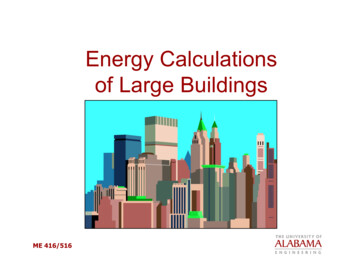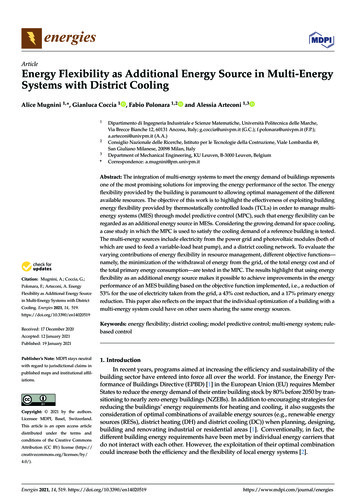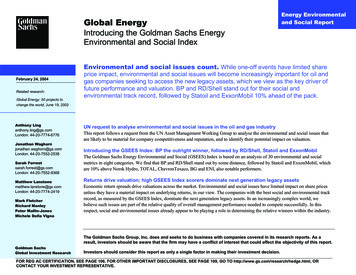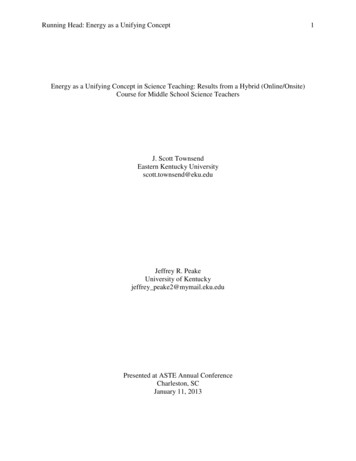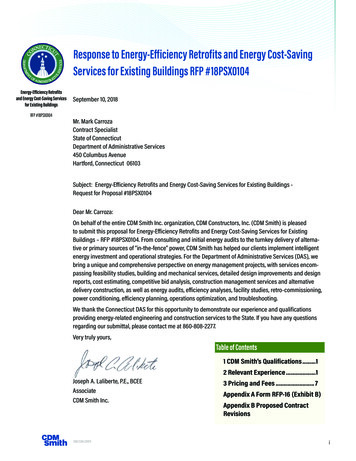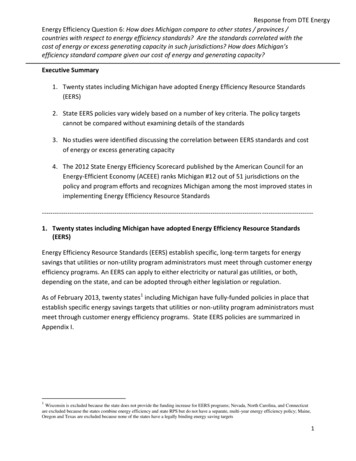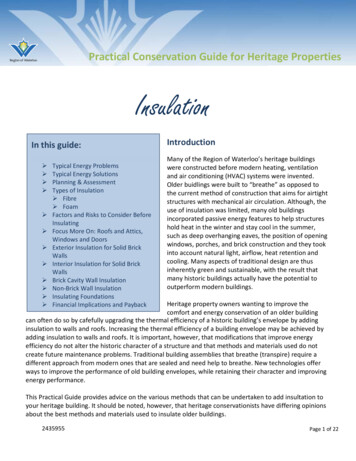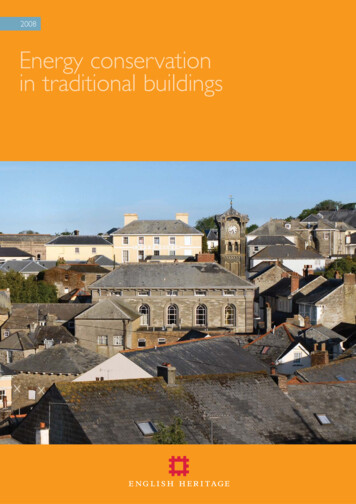
Transcription
2008Energy conservationin traditional buildingsEnglish Heritage
The information in this publication is based on currentknowledge. Whilst every effort has been made to ensurethe accuracy of the advice given, English Heritage doesnot accept liability for loss or damage arising from theuse of this information.This publication is intended onlyas a guide. It has no statutory authority, and should not beused as a substitute for professional advice.The guidanceprovided here deals only with the practical aspects ofinstalling the equipment.The acceptability of the installationwill depend on the historic significance of the building orsite being adapted.You are strongly advised to discuss theproposals informally with historic environment staff fromyour local council.The inclusion in this publication of any company,group or individual, or any product or service,should not be regarded as either a recommendationor an endorsement by English Heritage or its agents.PLANNING AND HISTORICBUILDING LEGISLATIONENGLISH HERITAGE SEEKS TO ENSURE THATANY WORKS TO A HISTORIC BUILDING DONOT UNNECESSARILY DISTURB OR DESTROYHISTORIC FABRIC.In decisions on how best to incorporate a renewabletechnology, the principles of minimum interventionand reversibility should be adopted whenever andwherever possible.Installing external applications or double glazing will probablyneed planning permission.The local planning authority cangrant permission under the Town and Country Planning Act1990, and they will be looking for any issues concerningvisual impact.Installing external applications or double glazing on alisted building or a building in a conservation area willalso need permission from the local planning authorityunder the Planning (Listed Buildings and ConservationAreas) Act 1990. Planning Policy Guidance (PPG) 15,Planning and the Historic Environment, can help youwith this; see www.planningportal.gov.uk. Work of anykind to a Scheduled Monument requires consent fromEnglish Heritage under the Ancient Monuments andArchaeological Areas Act 1979.CONTENTSINTRODUCTIONAre you sitting comfortably?Older homes are different122INSULATIONInsulating wallsInsulating below pitched roofsAmounts of insulationPlan the installation carefullyRemoving existing insulationGround-floor insulation4444555DRAUGHT-PROOFING6WINDOWSDouble glazingSecondary glazing999OTHER WAYS TOREDUCE ENERGY USE10GRANTS10USEFUL CONTACTSEnergy saving and climate changePlanning guidanceInsulation and draught-proofing11111111ACKNOWLEDGEMENTS11Front cover image showing buildings in Liskeard, Cornwall courtseyof Andrew More.
ENERGY CONSERVATION IN TRADITIONAL BUILDINGSINTRODUCTIONEnglish Heritage is the UK government’s adviser on the historic environment. Central toour role is the advice we give to local planning authorities and government departmentson development proposals affecting listed and traditional buildings, conservation sites andareas, terrestrial and underwater archaeological sites, designed landscapes and historicalaspects of the landscape as a whole.The UK government consider climate change is probably the greatest long-term challengefacing the human race and have made it a priority for the UK to cut our carbon dioxideconcentrations, which are believed to contribute to climate change.The UK government, wishing to reduce the country’s dependence on fossil-fuel storesand to cut carbon dioxide emissions, has made a national goal of reducing carbon dioxideby 20 per cent below 1990 levels by 2010 and, in the long-term, reduce emissions by 60per cent by 2050.They see this being achieved by every household and business takingmeasures to reduce their energy used.For more information on the UK government’s position on climate change, contact theUK Climate Impacts Programme (see Useful contacts).This guide looks at a range of improvements that can be made to reduce the heat lostthrough a building’s walls, windows, floor and roof. Most of these improvements are withinthe capabilities of a competent DIY enthusiast, but if you are not confident that you havethe necessary skills, seek expert advice and help.This guide is one of a series of guides looking at reducing energy consumption in traditionallyconstructed homes. While this guide considers improvements to a building’s performancethrough insulation and energy efficiency measures, other guides will focus on the applicationof small-scale renewable energy technologies, explaining how each system works and whatyou need to consider if you wish to install it in or on a historic building. All the guides lookat small-scale or ‘Microgeneration’ as it is known. Microgeneration is defined by Governmentas, “The production of heat and/or electricity on a small-scale from a low carbon source”.Before looking into alternative means of generating energy, it is important to investigate all availablemeasures for conserving it.These include low-energy light bulbs, heating controls and, as set out inthis guide, building insulation.Other guides in the series will cover solar energy, heat pumps and combined heat andpower, explaining how each system works and what you need to think about if you wishto install it in a traditional building.1
2ENERGY CONSERVATION IN TRADITIONAL BUILDINGSARE YOU SITTING COMFORTABLY?Before considering how to reduce heat loss from yourhome, consider the factors that influence your feelings ofcomfort. For most of us these are temperature, relativehumidity and air movement. Other factors are your age,the amount and type of clothing you’re wearing and yourlevel of activity.OLDER HOMES ARE DIFFERENTIn considering improvements for energy conservation itis important to remember that many traditional (historic)buildings perform very differently from modern buildings.Thought must be given to:We are all familiar with the effects of temperatureand humidity, especially during warm, ‘muggy’ summers.Humidity that is too low can also be a problem, makingthe air feel too dry; many of us have also experiencedthe shock of static electricity, which is more likely tooccur when humidity is low. Air movement also hasa big influence on comfort: air blowing across yourface may feel like a cooling breeze in summer, but inwinter the same air speed and temperature will feellike a cold draught. The importance of moisture movementin historic buildingsIt is also important to remember that we now dressdifferently to our ancestors. Heating in homes, cars,workplaces and shops leads many of us to dress ina very similar way all year round, lightweight clothingbeing the norm in many homes and offices even inthe middle of winter.1 Your home’s construction, to avoid causing damage Minimising disturbance to the existing fabric Reversing any changes without causing further damage Whether your home is of such quality that it shouldnot be alteredThe fabric of a traditional building usually needs to‘breathe’: to release and absorb moisture, for examplefrom rising damp, driving rain, defects and condensation.Moisture can move through traditional permeable buildingmaterials until it evaporates, internally and externally.Modern impermeable building products obstruct thisprocess: instead of keeping moisture out, they can oftentrap it inside, accelerating decay processes.The main risks to traditional (historic) buildings are: Moisture trapped within the building materials. Condensation within unheated areasof the building. Condensation at thermal bridges(see the box below), especially corners Ventilation and heating which are insufficientfor removing moistureIn a permeable building, it is important not to reduceventilation rates too much, as this could trap moisturewithin the building.Successful control of moisture levels in atraditional (historic) building may depend on:WHAT DO WE MEAN BY A TRADITIONAL BUILDING? Solid-wall construction Bay or sash window, single glazed No damp-proof course Likely to have been built before 1919 Adequate ventilation Use of building materials that are ‘hydroscopic’which allows moisture movement into and outof the building materials. Minimising barriers to moisture flow
ENERGY CONSERVATION IN TRADITIONAL BUILDINGS2As a rule of thumb, a traditional building needsto be ventilated at a rate of 0.8 to 1.0 air changesper hour – twice that for a modern building.Since infiltration rates in many traditional buildingsexceed this value, draught-proofing is normallybeneficial3
4ENERGY CONSERVATION IN TRADITIONAL BUILDINGS4INSULATIONYou must maintainventilation in theroof spaceINSULATION MATERIALSFOR TRADITIONAL BUILDINGSNatural fibre-based materials such as sheep’s wool andhemp fibre are suitable for use as insulation in traditionalbuildings.These have good thermal insulation propertiesand do not hinder the movement of moisture.Materials such as fibreglass and mineral wool havea tendency to hold moisture. In older buildings thiscan increase the risk of damp, timber decay andmould growth.In selecting the most appropriate insulation material itis important to ensure that it will continue to performfor many years to come. If the material is likely to settlethen allowance should be made for this, including meansto prevent it from flowing out through the eaves orbeing blown about in the loft space if there is strongair movement.INSULATING WALLSWith their solid walls, traditional buildings can potentiallybe insulated either internally or externally. Internal liningof rooms is possible within the competence of DIY, butexternal application is best left to competent builders.In either case you should seek expert advice beforeproceeding, as the works are likely to require buildingcontrol and, if your building is protected (listed or ina conservation area), planning consent.3Where has all the heat gone? Reducing heatloss and draughts keeps the heat where youneed it – inside your homeINSULATING BELOW PITCHED ROOFSInsulation above the top floor ceiling is one of the easiestand cheapest means of improving a building’s energyefficiency. It can be carried out successfully in traditionaland historic buildings if it is approached with care andconsideration for their special circumstances, particularlythe risk of condensation. Relatively thick layers of insulationwill not cause problems if they are installed carefully andif the materials are compatible with the performanceof older buildings. Loose-fill cellulose insulation can beinstalled between ceiling joists as a DIY improvement.If you already have some insulation you could simplyadd to what is already there. When laying additionalinsulation make sure you maintain the air flow throughthe loft space.If you wish to lay loft boards or flooring in order touse your loft space for storage, you may need to firstadd additional timber joists on top off at right anglesto the existing floor joists to provide enough depthfor the insulation.By reducing heat flow from below, improving insulationin this way will reduce the temperature in the loft space.If you have water tanks and pipes in the loft space, makesure that these too are adequately insulated, to stopthem freezing. Check also that no electric cables orlights are covered with insulation as this could causethem to overheat.AMOUNTS OF INSULATIONTo meet current good practice you will need abouta 250mm thickness of sheep’s wool, 250mm of hempor 225mm settled thickness of cellulose fibre insulation.Make sure that the existing ceiling can take theextra weight of additional joists and insulation.
ENERGY CONSERVATION IN TRADITIONAL BUILDINGSPLAN THE INSTALLATION CAREFULLY5Place no insulation directly below the cold-water tank:heat from the room below helps prevent the tankfrom freezingThermal bridge: If thermal performance isimproved in one area with the addition ofinsulation, while an adjacent area is not insulated,a local cold spot – known as a thermal bridge orcold bridge – is created.Most traditional buildings were not designed withinsulation in mind. Before starting, plan how you willdo it. Draw a sketch of the floor of the loft, and considerthe following questions: How will each corner and awkward area be insulated? Will building paper be needed to separate insulationfrom damp walls? Will eaves ventilators be required to prevent insulationfrom blocking ventilation? Are there areas of sloping ceilings? These will needspecial attention, for example access maybe difficult. How will you move around the loft space when theinsulation is in place? What areas need access, and where will items bestored? What about access for maintenance, includingto small or awkward spaces?When handling mineral wool or fibreglassinsulation you should wear protective clothing,including a dust mask, at all times. Are services in the loft space out of use or likely toneed repairs or upgrading in the near future? Is thisa good opportunity to remove redundant pipe andcable runs, aerials etc, or to renew that oldcold-water tank?GROUND-FLOOR INSULATIONUndertaking floor insulation is likely to be beyond thecompetence of all but the most experienced. It shouldonly be considered if other major refurbishment worksare planned to the ground floor. How will plumbing in the loft space be insulated?These works will require major disruption in the liftingof existing floor finishes, and possible ground excavationsin the case of solid floors, so it is best to leave them toexperienced building contractors. Will wiring in the loft space need renewal in thenext few years? Will it be accessible once the spaceis insulated?Where blown or vertical insulation is requiredthis must be carried out by an approved specialistcontractor such as a member of the NationalAssociation of Loft Insulation Contractors.REMOVING EXISTING INSULATIONExisting loft insulation is likely to be of fibreglass or mineralwool, not really suitable for older buildings. If the insulationis old, in poor condition or poorly installed you shouldreplace it. If there are any signs of dampness in the rooftimbers, such as staining or funga
occur when humidity is low. Air movement also has a big influence on comfort:air blowing across your face may feel like a cooling breeze in summer, but in winter the same air speed and temperature will feel like a cold draught. It is also important to remember that we now dress differently to our ancestors. Heating in homes, cars,
